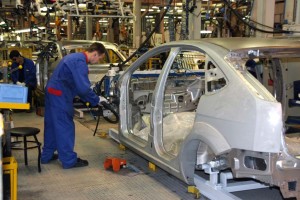
Ford is hunkering down for the long haul in Russia while GM is cutting back its operations while the market there continues its free fall.
It was the best of times, it was the worst of times … “it” is the current state of the auto industry in Russia.
What was once considered the next great promised land of auto sales in Europe has now become a dicey proposition with two of the big U.S. players – General Motors and Ford – taking different approaches to the market. GM’s is cutting its losses while Ford is hunkering down for the long haul.
The light vehicle market is cratering, posting its biggest monthly decline in Russia in about five years in March when it slid 42.5%, according to the Association of European Business. Through the first quarter of 2015, sales in the country are down 36.3% compared with year-ago figures.
The Russian light-vehicle market is currently undergoing something of an existential crisis as a unique combination of macroeconomic and political circumstances are completely undermining any possibility of positive sales growth in the market, according to IHS Automotive.
GM recently announced it was pulling up stakes and getting out with the closure of its facility in St. Petersburg and taking a $600 million charge to do it. The company will close the plant by the middle of this year with the contract assembly of Chevrolet vehicles at GAZ discontinued by the end of 2015.
“This change in our business model in Russia is part of our global strategy to ensure long-term sustainability in markets where we operate,” said GM President Dan Ammann. “This decision avoids significant investment into a market that has very challenging long-term prospects.”
The only car it will manufacture in Russia after December is the small sports utility vehicle, the Chevrolet Niva, which it makes with its local partner AvtoVAZ.
In addition to producing the Niva, GM will continue to import the Chevy Corvette and large SUVs into the country in small numbers, as well as Cadillacs. Otherwise, it is essentially shutting everything down and waiting for the storm to pass.
GM’s sales have slid precipitously during the last two years: 288,000 vehicles in 2012; 258,000 in 2013; and 189,000 last year. Overall, Russian auto sales fell 10% in 2014 to 2.3 million units.
This year hasn’t started any better. Through February, sales fell 38% on the year. Chevrolet sales fell 74%.
Adding to the sales misery, it’s expensive for GM to build cars in Russia because it doesn’t have a supplier base there. Thus, it imports components from European suppliers. It pays those suppliers in rubles, which has lost about 50% of its value, forcing GM to pay twice as much for parts as sales have slowly declined: not exactly a plan for economic success.
(New car sales freefalling in Russia. For more, Click Here.)
Conversely, Ford is hunkering down and taking the long view despite the economic roller coaster that is the Russian economy. It has been engaged in a joint venture with Sollers and expects that to produce solid results in the short term, leaving the Dearborn, Michigan-based maker poised to pounce once stability returns.
“Essentially what we see in Russia is that it’s a big and important market, even in it’s reduced rate right now, it’s still going to be one of the bigger markets in Europe,” said Mark Fields, Ford’s CEO during the company’s earnings call today.
“We still hold the view that when the market stabilizes and ultimately recovers, that this could be one of the biggest, if not the biggest, markets in Europe and it’s important for us to be there.”
He noted that the company has been investing in the country and expects to have a full line-up for consumers there by the end of this year.
(Click Here for details about how a deal with Iran could open a new market for automakers.)
“We have a very good working relationship with Ford Sollers,” he added. “I think we’re very well positioned in Russia when we see stabilization and growth and that will not only have benefits for Russia but also benefits for our European business.”
While the approaches are different – and neither automaker is the only one pursuing either direction – both may end up being a good choice, according to Stephanie Brinley, senior analyst at IHS Automotive.
“The problem is the market is in a freefall and we don’t know when it’s going to get better,” she said. She said GM isn’t abandoning Russia, but they’ve clearly figured out its cheaper and more prudent to import selected vehicles in to the country in low volumes than try to build at volume.
The automaker’s focus is on making its European operations profitable and this move will help them do that, she added. Ford’s strategy also makes sense because they’ll engender some goodwill by remaining there during the tough times and they can afford to do so. However, success will be determined by when the turnaround comes.
(To see more about why Chrysler is pulling out of the U.K., Click Here.)
“It’s a really risky market right now,” Brinley said. “There’s reason to expect it to improve over time. It’s like Brazil in that sense, but the improvements aren’t as clear as in Brazil, which is going to take at least two years.”

The Russian economy has been a house of cards for a decade or more so this is no real surprise. China sales will eventually plateau also. Without China many a car maker would have dismal current profits.
If I was a modern day Russian, I’d feel lucky if a dim outlook for the car business were the worst part of my recent life. Now, if they go to 15-year financing like Chevy in Colombia, market might perk.